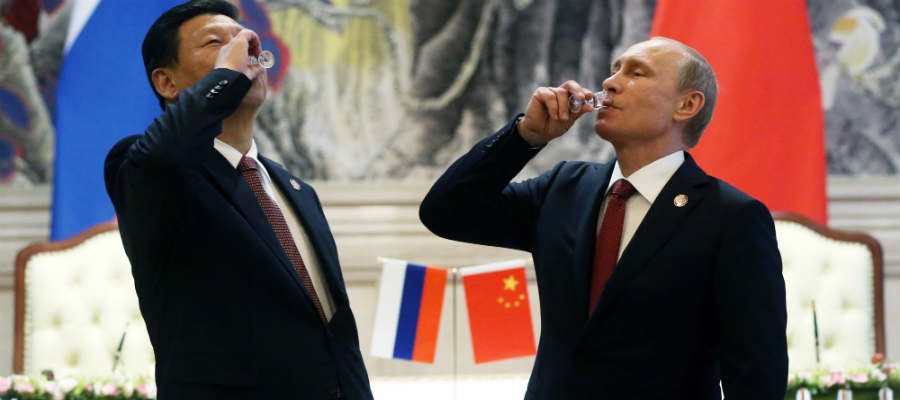BY MANOJ KEWALRAMANI
China’s response to the recent protests for democratic change in North Africa and the Arab world has been one that has mixed caution with aggressive diplomacy.
This article offers a brief assessment of China’s response to what has come to be known as the Arab Spring. I shall do so at two distinct levels. The first part of the article focuses on the strategy adopted at home in order to check dissent, while the second section addresses Chinese efforts at balancing its alliances in order to ensure that its strategic and energy interests are safeguarded.
The Jasmine Revolution that forced out the long-serving Tunisian president Zine El Abidine Ben Aliand soon spread across borders inspiring large scale street protests in different parts of the Arab world caught most of the world by surprise. While the dynamics of protests and demands differed from nation to nation, there emerged a common underlying narrative, i.e., unelected and undemocratic regimes that did not respect basic human rights no longer held legitimacy with people. In that context, it was scarcely a surprise that uncomfortable questions would be raised, domestically and internationally, about the legitimacy of the Chinese regime.
The first real sign that calls for revolution were gaining currency in China was evident in the end of February. An anonymous protest appeal on Buxon.com urged people in 13 cities across the country to take to the streets on February 20.
In response, the Chinese government adopted a two-pronged strategy. The first part of this was to deal with any potential “trouble-makers” with an iron fist.Despite the fact that only a handful of people, reportedly 200 odd in Beijing and 100 in Shanghai, turned up for the protest on February 20, the police responded firmly, dispersing and detaining protesters, sending a clear message that even tepid challenges to the regime would be dealt with appropriately. Soon after, the state began cracking down on human rights activists, artists and writers. The most noted amongst these has been artist Ai Weiwei, who was arrested in early April. That was accompanied with strict control over the Internet and social media networks.
The second part of the strategy was combating the dissenting voices with a calculated propaganda campaign. US Ambassador John Huntsman’s interaction with protesters in Beijing on February 20th afforded the perfect opportunity rile up nationalistic and anti-American fervor. A brief snapshot of the Chinese blogosphere, offered by Jacob Zenn for the Asia Times, reveals the potency of this sentiment.
Meanwhile, several Chinese commentators went to great lengths to draw distinctions between the one-party, socialist system and Arab monarchies. The Arab regimes were described as feudal and self-serving dictatorships that failed to invest in their people, resulting in economic stagnation.
In contrast, the Chinese state was defined as robust with a strong central leadership, which was premised on collective decision-making, the absence of individual monopoly over power, the grassroots network of the CCP. Its success and superiority could be gauged by the rapid economic prosperity and improved standards of living experienced by citizens along with the state’s ability to respond swiftly to disasters, such as the Sichuan earthquake of 2008.
On the international stage, meanwhile, China remained rather circumspect in its response to the unfolding events. However, with the passage of time, a clear strategy appears to be taking shape.
With the tectonic shift that the region is undergoing, China has moved to rebalance alliances and project itself in a new light. The goal here appears to be one of securing crude and gas supplies while positioning itself as a responsible regional facilitator, which stresses on non-interference in internal affairs and shares a strong relationship with nearly all of the key players.
The first steps toward that end were taken in mid-March, as Beijing dispatched its special envoy for Middle East affairs, Wu Sike, for a whirlwind trip through Israel, Palestine, Syria, Lebanon and Qatar.
In the statements emerging since then, Chinese officials and academics have described the failure of US policies, particularly in the context of the Israeli-Palestinian conflict, as one of the key factors for the regions ills. Such positioning is critical, considering Hamas and Fatah’s reconciliation efforts and the anticipated declaration of statehood by Palestine in September UNGA meet.
In terms of its energy needs, China imports approximately 58 percent of its oil from the Middle East. This figure is estimated to grow to 70 percent by 2015. Saudi Arabia is by far the largest exporter of crude to China, with Iran a distant second. Thus far, despite the growing shrillness between Riyadh and Tehran over the latter’s suspected role in supporting Shiite movements in the Gulf, China has walked a fine line not to upset its ties with either of them. In fact, in a world where the US and EU’s ability to influence the Islamic Republic remains limited, China finds itself in a unique position of strength, being Tehran’s largest trading partner.
Meanwhile, Beijing has also moved to deepen its cooperation with Moscow. The recent visit of Foreign Minister Jiechi resulted in an announcement of “tight cooperation” between the two nations on regional issues, while setting the stage for greater exports of gas to China. Moscow remains critical for China to counterbalance Western influence in the Middle East, while diversifying its energy imports.
Thus, at a geo-strategic level, China, despite initially seeming rather reluctant to get entangled the shifting political architecture of the Middle East, has slowly begun to rebrand and re-position itself as an responsible stakeholder and a unbiased broker, while working to secure uninterrupted oil flow.
(This article first appeared on the website of Centre for Land Warfare Studies on May 24, 2011)
